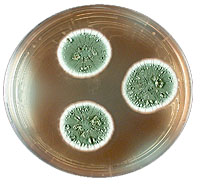Biotechnology
Multivariate Statistics in Predictive Biotechnology
 The aims of the studies are based on the main hypothesis that the combination of multivariate statistics and image analysis of features can be used as a tool in (visual and chemical) database identification processes within isolates from the fungal genera Penicillium and Aspergillus. Databases of functional characteristics are expected to be complementary to the known DNA-sequence based databases.
The identification is based on visual as well as secondary metabolite profiles. Secondary metabolites are end products of the bio-chemical processes that take place within cells of all living organisms, and they are therefore indirectly descriptive of the cells metabolic processes. If different cells use different processes, there will also be a difference in the variety of metabolites produced. Furthermore the chemical variation in the metabolites can be directly related to ecology and habitat.
more
The aims of the studies are based on the main hypothesis that the combination of multivariate statistics and image analysis of features can be used as a tool in (visual and chemical) database identification processes within isolates from the fungal genera Penicillium and Aspergillus. Databases of functional characteristics are expected to be complementary to the known DNA-sequence based databases.
The identification is based on visual as well as secondary metabolite profiles. Secondary metabolites are end products of the bio-chemical processes that take place within cells of all living organisms, and they are therefore indirectly descriptive of the cells metabolic processes. If different cells use different processes, there will also be a difference in the variety of metabolites produced. Furthermore the chemical variation in the metabolites can be directly related to ecology and habitat.
more
Contact:
Michael Edberg Hansen
Image Analysis of 2D Gel Electrophoresis Images
 The main goal of this project is to investigate and develop methods to partly automate and ease the tedious and time consuming task of locating, quantifying, and matching protein spot patterns in series of 2D electrophoresis gel images. The image shows an example with 1900+ proteins represented as dark spots on the bright background.
The principles in 2D electrophoresis process are as follows. The protein contents of a biological sample, e.g., a blood sample or a tissue/bone biopsy can be separated using the 2D electrophoresis technique. The proteins are separated in two dimensions according to iso-electic focus point (horizontal direction) and molecular weight (vertical direction), respectively. The values of these two properties determine the spatial position of each protein spot.
The main goal of this project is to investigate and develop methods to partly automate and ease the tedious and time consuming task of locating, quantifying, and matching protein spot patterns in series of 2D electrophoresis gel images. The image shows an example with 1900+ proteins represented as dark spots on the bright background.
The principles in 2D electrophoresis process are as follows. The protein contents of a biological sample, e.g., a blood sample or a tissue/bone biopsy can be separated using the 2D electrophoresis technique. The proteins are separated in two dimensions according to iso-electic focus point (horizontal direction) and molecular weight (vertical direction), respectively. The values of these two properties determine the spatial position of each protein spot.
Contact:
Bjarne K. Ersbøll